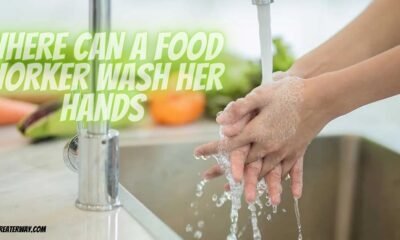FOOD
WHICH SITUATION REQUIRES A FOOD HANDLER TO WEAR GLOVES

WHICH SITUATION REQUIRES A FOOD HANDLER TO WEAR GLOVES? Proper food handling is of utmost importance in ensuring the safety and well-being of consumers. One essential aspect of food safety is using gloves by food handlers. Gloves act as a barrier between the food being prepared and the hands of the handlers, minimizing the risk of contamination. One key aspect of food safety is the appropriate use of gloves. Gloves act as a protective barrier between the food handler and the food, preventing the transmission of harmful pathogens, bacteria, and contaminants.
- Food Preparation and Handling:
Food handlers should wear gloves? when preparing and handling ready-to-eat foods. This includes activities such as slicing, chopping, dicing, or assembling food items. Gloves protect against transferring bacteria, viruses, or other contaminants from the handler’s hands to the food, minimizing the risk of food borne illnesses. Whether it is a sandwich shop, salad bar, or any food establishment that serves ready-to-eat foods, gloves are essential to maintain cleanliness.This ensures that any potential contamination from the food handler’s hands, including bacteria or viruses, is minimized.
- Handling Raw Foods:
Food handlers must wear gloves when dealing with raw foods, especially those of animal origin. Raw meats, poultry, seafood, and eggs are often contaminated with harmful pathogens such as Salmonella, E. coli, or Campylobacter. Wearing gloves when handling these items prevents cross-contamination, ensuring that the pathogens are not transferred from the hands to other surfaces, utensils, or ready-to-eat foods.The use of gloves helps maintain a physical barrier between the handler’s hands and the raw food, reducing the risk of cross-contamination and potential foodborne illnesses.
- Handling Allergenic Ingredients:
Which situation requires a food handler to wear gloves? Certain ingredients, such as nuts, shellfish, or gluten, can trigger severe allergic reactions in susceptible individuals. Food handlers should wear gloves when working with these allergenic ingredients to prevent cross-contact. Even trace amounts of allergens can lead to allergic reactions, so gloves are a protective barrier to avoid unintentional contamination and subsequent health risks.
- Dealing with Open Wounds or Sores:
If a food handler has an open wound, cut,sore,or skin infection on their hands, gloves are mandatory. Open wounds can harbor harmful bacteria and pathogens, which can easily transfer to the food during handling. Wearing gloves protects the food & prevents the handler’s wound from being exposed to potential contaminants, promoting personal hygiene and health.
- Serving Ready-to-Eat Foods:
Food handlers should always wear gloves when it comes to serving ready-to-eat foods. This includes activities such as plating, garnishing, or arranging food items on plates or trays. Gloves act as a protective barrier, preventing direct contact between the handler’s hands and the food, ensuring cleanliness and reducing the risk of contamination.
- Cleaning and Sanitizing:
Gloves are essential during cleaning and sanitizing processes in food establishments. Cleaning chemicals, sanitizers, and hot water can cause skin irritation or burns to the hands. Wearing gloves protects food handlers from potential injuries and chemical exposures and maintains hygiene standards throughout the class.
- Personal Hygiene Practices:
Food handlers should wear gloves as part of their hygiene practices. This includes touching the face, hair, or other body parts while handling food. Gloves act as a reminder and physical barrier, preventing the transfer of any potential contaminants from the handler’s body to the food, ensuring food safety and hygiene.
The use of gloves by food handlers is crucial for maintaining food safety & preventing the spread of contaminants in various food service settings.
This article aims to explore the specific situations in which the use of gloves is necessary, helping food establishments and their staff uphold the highest standards of food safety.



